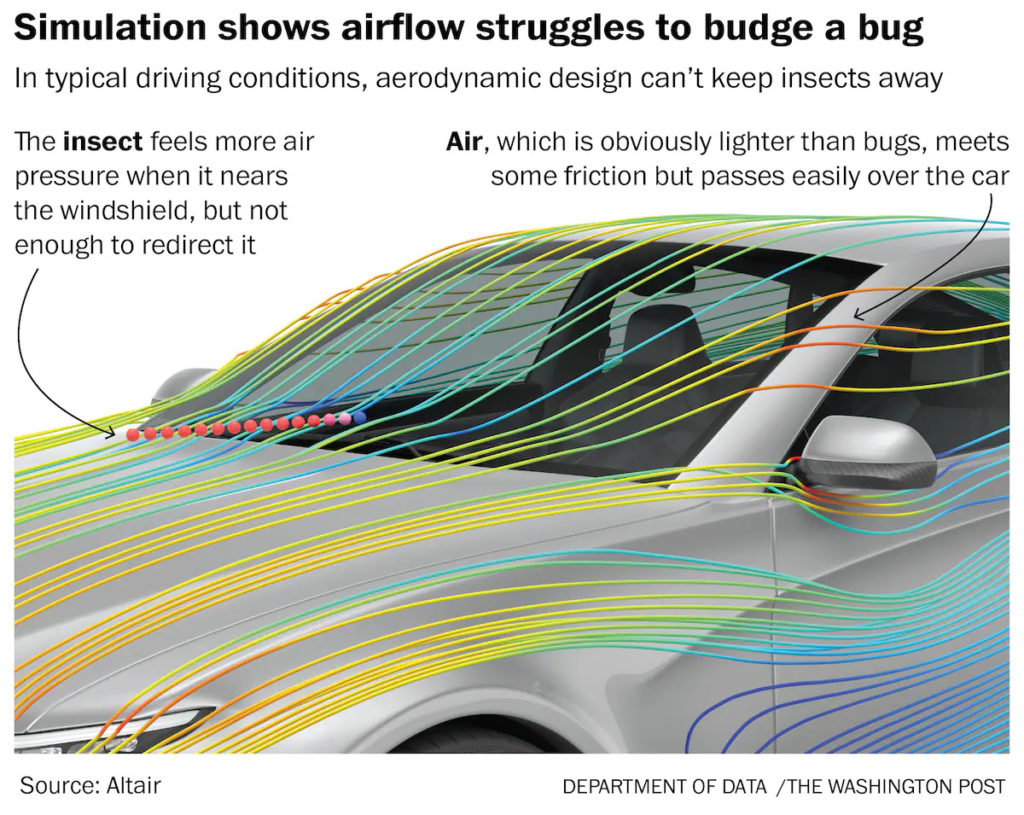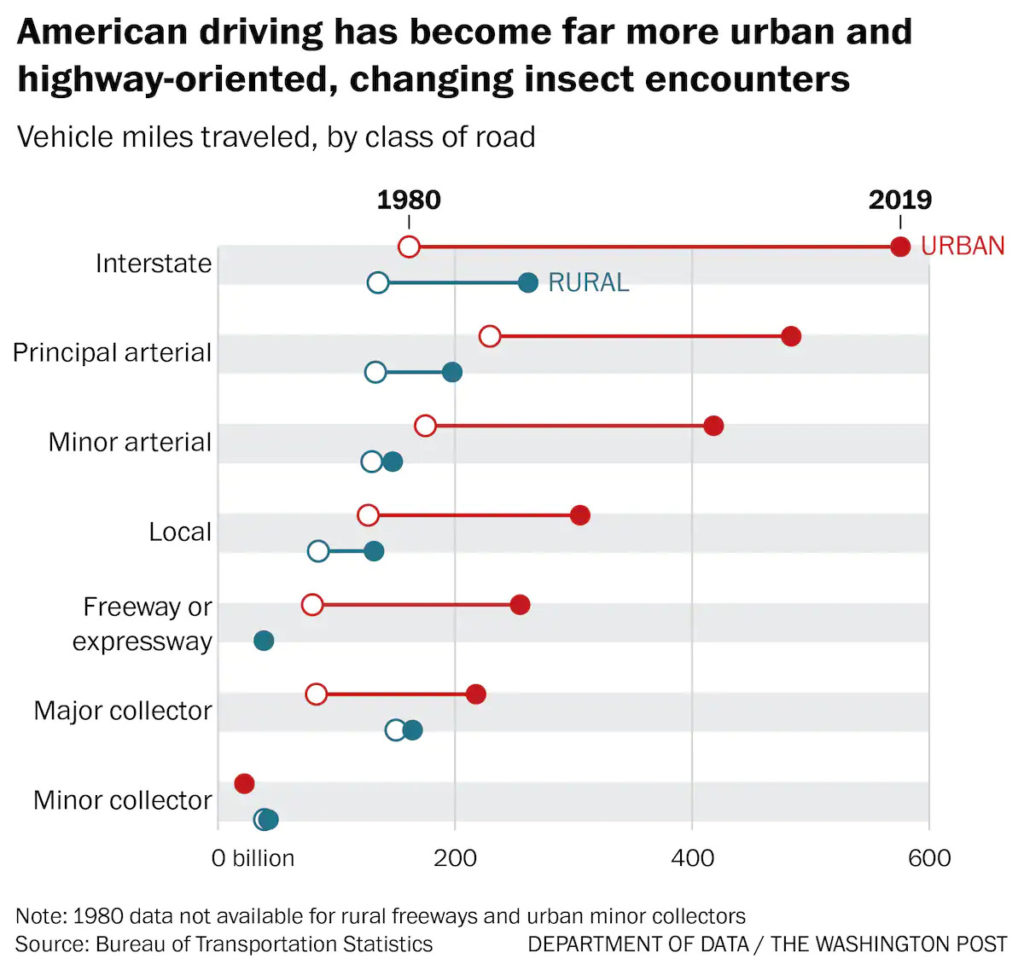Original publication by Andrew Van Dam for washingtonpost.com on 21 October 2022

(iStock)
After a long drive, the only thing that makes our stomachs churn faster than a windshield smeared with bug guts is a windshield bearing no evidence of insect life whatsoever. It feels like a fundamental pillar of the planet’s ecology has snapped.
You’ve probably noticed it, too. On long summer road trips, tiny corpses once formed a crust so thick that the reduced visibility posed a legitimate safety risk. Now, many folks we spoke with can’t remember the last time they had to scour the bug gore from their RAV4.
Before we address possible causes of the “windshield phenomenon,” such as more aerodynamic cars, we should make one thing clear: It’s not a mass delusion or faulty collective memory. Windshield splats are valid ecological data, and they don’t bear good news.
One of the first to realize their potential, in 1996, was Anders Pape Moller, a Danish biologist with (a) the iconoclastic streak necessary to even consider using windshields as a bug-measurement device and (b) the stubbornly ferocious work ethic needed to see the scheme through.
Moller, who now works at high-ranked Paris-Saclay University, said he began studying birds — and the insects they eat — in the late 1960s. In the mid-1990s, he got it in his head that counting windshield splatters might help track difficult-to-measure insect populations. He couldn’t persuade a graduate student to take up the observations, so he hit the roads himself.
Every summer, despite serious health issues that have kept him in and out of hospitals for the past decade, he and his assistants return to Denmark to drive battered budget vehicles back and forth, hundreds of times, along the same rural routes studded with farms in the north of Denmark’s Jutland peninsula.
They keep their speed consistent. They track temperature and wind conditions. And they count the number of bug splats, large and small. They also track bug populations with more conventional entomological methods, catching them in nets and sticky traps, and counting how many insects local swallows are feeding their chicks.
It’s one of the most idiosyncratic and impressive feats of data collection we’ve seen. And Moller’s windshields establish empirically what we’ve all seen anecdotally.
From 1996 to 2017, insect splatters fell by 80 percent on one of the routes Moller regularly travels. On the other, longer stretch, they plunged 97 percent. Conventional measures show similar trends, and more recent observations have seen even sharper declines, Moller told us.
Experts say the lack of insect innards on our summer windshields is just one symptom of a broader decline in insect populations worldwide. But how much are insects declining? We’re not sure.
Insects are astonishingly widespread and astonishingly weird, and we knowcomparatively littleabout them. We’ve only got a few hundred long-term studies of their populations — typically isolated efforts by people like Moller who are sometimes interested in the insects mainly as bird food or crop pests. We know literally nothing about the vast majority of what could be as many as 10 million insect species out there.
Bugs are also just harder to measure than more widely tracked animals. Their numbers swing wildly year to year, season to season, even sometimes day to day. And while the overall trend leads inexorably downward, it’s not uncommon for individual studies to show a local insect population rising.
So, given this uncertainty, isn’t it possible that our spookily clean windshields are caused by factors other than rapidly declining insect populations? After all, we still see bugs everywhere, we just don’t seem to mash them with our cars as much.
Many smart people we spoke with, including entomologists and wheat farmers, speculated that maybe the cars have changed, not the bugs. As vehicles become more aerodynamic, the thinking goes, their increasingly efficient airflow whisks the bugs away from the windshield instead of creating head-on splatters.
But when we called experts in the arcane art of computational fluid dynamics, they sounded skeptical. Yes, today’s sleek sedans can have half the drag of the land boats that ruled the road just a generation or two ago. But that improved airflow won’t do much for a bug.
For starters, many aero improvements happen on the rear of the car rather than the bug-hitting front. Consider the optimally aerodynamic teardrop shape, with its blunt, round front and long, sleek tail. But more importantly, it’s just surprisingly difficult to use air to push a bug out of the way of an onrushing Buick.
If it were possible to design a bug- and debris-proof car, then Kevin Golsch probably would have done it by now. An auto-industry veteran, Golsch has spent decades around wind tunnels, both real and simulated, and is now vice president for strategic fluid design and simulation at Altair, a global tech company that makes simulation and AI software. Altair’s customers include massive automakers that would be thrilled if airflow could protect both windshields and the delicate sensorsonself-driving cars.
“From an aerodynamic standpoint, I’ve done a lot of studies on contamination of sensors, especially for autonomous vehicles,” Golsch said. “And I think most everybody’s given up on trying to influence what happens at the vehicle level for dust and particles and rain.”
Consider raindrops. They’re about the size and weight of a larger insect, but nobody thinks fewer raindrops hit our windshields these days. Any forces that cleared our windshield of bugs would presumably do the same for rain and road debris, Golsch said.

To be sure, one element of modern auto design could be reducing bug spatter. Windshields today often have a lower slope than the more-vertical front windows of yesteryear, and while the broader shift to SUVs and trucks with bigger, steeper windshields will negate some of that, it might reduce splats for people who are driving similar vehicles.
In America, trucks are in the driver’s seat
U.S. vehicle sales, in millions, at a seasonally adjusted, annual rate

“If the windshield was laid back slightly more than another windshield, that bug may have a chance of just skipping off and going up over the windshield rather than hitting the windshield,” Golsch said. “It might be a glancing blow at the last second rather than a splat.”
But we also saw 60 percent declines in insects between 2004 and 2021 in a British study from the Kent Wildlife Trust, which built on a Royal Society for the Protection of Birds effort in which thousands of people used “splatometers” to measure bug splatters on license plates, which aren’t much affected by aerodynamic advances elsewhere.
So, there are fewer dead bugs regardless of aerodynamics. But we couldn’t ignore the multitudes of smart people who told us they believed something had changed with automobiles.
Desperate for answers, we woke up during the Italian workday and called Matteo Aroni at Ansys, which models physics for car and aerospace firms. Aroni, an expert in calculating how air flows around cars, casually mentioned that if there is a finite number of bugs that are roughly evenly distributed, the number of bugs splattered must be a function of the area of the windshield. And suddenly, everything clicked into place.
When you strip away the other variables, what we’re really measuring when we drive through the countryside is a simple fraction: bugs per windshield.
We know the numerator, bugs, has gone down. But what about the denominator?
The number of windshields — or, more accurately, miles traveled by each square foot of windshield, since our driving habits and windshield sizes differ — has soared!
A nation of motorists
Monthly vehicle miles traveled in the United States

Americans now drive three times as many miles as they did in 1970, and the explosion of trucks and SUVS means many of us do it in cars with much, much larger windshields. Back-of-the-napkin math suggests acreage of windshields out on the Americanroad has tripled. And that’s probably an underestimate in some places: A large majority of our increase in driving has come on a narrow set of major urban roads, according to our analysis of Bureau of Transportation Statistics data. And as Kenny Cornett of design-software giant Autodesk points out, more traffic means more vehicles riding in each other’s bug-free aerodynamic slipstreams.

So in our little thought experiment, which makes the depressingly accurate assumption that bugs are a finite resource, our bugs-per-windshield metric would have been cut by two-thirds even if the number of bugs had remained constant. And it hasn’t! It’s fallen precipitously.
So, simple math hints that the very real ecological disaster of the collapse of insect populations may look even more apocalyptic thanks to the parallel rise of another ecological time bomb: the world’s intensifying love affair with ever more and ever bigger automobiles.




